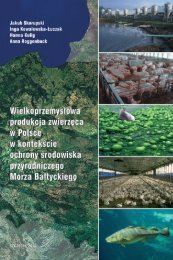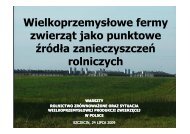best available technologies for manure treatment - Baltic Green Belt
best available technologies for manure treatment - Baltic Green Belt
best available technologies for manure treatment - Baltic Green Belt
You also want an ePaper? Increase the reach of your titles
YUMPU automatically turns print PDFs into web optimized ePapers that Google loves.
Best Available Technologies <strong>for</strong> <strong>manure</strong> <strong>treatment</strong> baltic sea 2020<br />
Best Available Technologies <strong>for</strong> <strong>manure</strong> <strong>treatment</strong> baltic sea 2020<br />
ANNEX E: TABLES WITH SHORT DESPRIPTION OF LIVESTOCK MANURE TREATMENT TECHNOLOGIES<br />
Ref No. 42 Drying and pelletizing<br />
Brief description<br />
It is not possible to store the fibre fraction from slurry separation offhand, and that is a parameter which reduces the interest<br />
<strong>for</strong> separation.<br />
Though it is possible to dry the fibres followed by a pelletizing process and then be able to store it. The smell is reduced by<br />
this process as well.<br />
If installed on a biogas plant, the heat <strong>for</strong> the drying is provided by exhaust gas from gas motors. The dryer is typically a cocurrent<br />
rotary dryer. The hot exhaust gas makes the water evaporate by direct heating. After the drying unit the final product<br />
is separated by gravity in a separation chamber. The dry sludge (90 % dry matter) falls through a rotation feeder valve into a<br />
screw conveyor that transports the final product to a store. The separated gas from the dryer flows into a series of cyclones. A<br />
blower, situated after the cyclones, ensures the gas flows in the whole drying system.<br />
Some new variations of this technology re-uses the steam from the evaporation process <strong>for</strong> heating up purposes. And thereby<br />
a much better energy balance.<br />
After the drying process the dry fibres are often pressed into pellets during a pelletizing process. Thereby the volume of the<br />
biomass will decrease significantly, and the result is a homogenous storable biomass.<br />
The investment is rather heavy, and too expensive to install on a single farm plant. But it might be quite interesting <strong>for</strong> bigger<br />
common separation – or biogas plants.<br />
The investment price below is based on a capacity at 1,5 tonnes per hour.<br />
Innovation stage<br />
Research<br />
Pilot<br />
Practice <br />
Major references<br />
Investment price, <br />
Basic Variable<br />
Heavy.<br />
Drying: <br />
250.000<br />
Pelletizing: <br />
200.000<br />
Condition <strong>for</strong><br />
leaching<br />
reduction<br />
effect<br />
CBMI, 2009 Scenarios II - V<br />
50<br />
Operational costs,<br />
per tonnes<br />
10 – 40<br />
- Dependent on type of<br />
technology and the local<br />
energy prices.<br />
Certainty of in<strong>for</strong>mation<br />
Prices Medium<br />
Effect on leaching High<br />
Description of the effect on leaching<br />
(positive or negative) of N and P<br />
Leaching reduction is associated with the<br />
spreading effect, described above.<br />
Complete drying of the fibre fraction<br />
makes it economically possible to<br />
transport the product far away to areas<br />
with low livestock density.<br />
per kg saved N or P leaching Complexity of implementation<br />
Experience from Spain is that pellets with a<br />
content of 7:5:6 NPK alone in heat<br />
consumption costs 17 kWh heat per kg<br />
pellets <strong>for</strong> the drying using the traditional<br />
technology. The heat consumption includes<br />
heat used <strong>for</strong> other processes in the plant.<br />
To this comes the depreciation and running<br />
of the plant. However, commercial solutions<br />
are seen, where the heat from burning the<br />
pellets are more than sufficient to run the<br />
drying process.<br />
High – this technology is not a<br />
stand-alone technology, but is<br />
part of a complex livestock<br />
<strong>manure</strong> <strong>treatment</strong> plant with<br />
<strong>technologies</strong> like pH-adjustment,<br />
mechanical separation, and<br />
other.<br />
The technology is not suitable<br />
on single farm plants.<br />
66<br />
66








